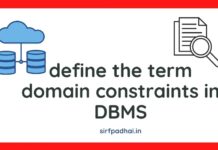
(1) Mapping Cardinalities:- Mapping cardinalities can be defined as the number of entities to which another entity is associated via relationship set. Binary relationship sets are described easily by using mapping cardinalities.
for a binary relationship set R between entity sets 1 and 2, the mapping cardinality can be one of the following-
(a)One to One- This is expressed as an association between an entity in set 1 to at most one entity in set 2, and an entity in set 2 to at most one entity in set 1.
(b) One to Many- This is expressed as an association between an entity in set 1 to any number (zero or more) of entities in set 2. However, an entity in set 2 can be associated with at most one entity in set 1.
(c) Many to One- This is expressed as an association between an entity in set 1 to at most one entity in set 2. However, an entity in set 2 can be associated with any number(zero or more) of entities in set 1.
(d) Many to Many- This is expressed as an association between an entity in set 1 to any number (zero or more) of entities in set 2, and an entity in set 2 to any number (zero or more) of entities in set 1.
(2) Participation Constraints- The participation of an entity set in a relationship set is expressed as a total participation if each entity in entity set participates in at least one relationship in relationship set. If only some entities in entity set participate in relationship in relationship set, the participation of entity set in relationship set is expressed as a partial participation.
(3) Attribute Inheritance- Attribute inheritance is an excellent property of the lower-and higher-level entities created by specialization and generalization. In this case, the lower entity sets inherit the attributes of the higher-level entity sets. A lower -level set also inherits participation in the relationship sets in which its higher-level entity participates.
The result is usually the same whether a predetermined portion of an E-R model was found out by specialization or generalization-
(a)A higher-level entity set with relationships and attributes that apply to all of its lower- level entity sets.
(b)Lower- level entity sets with different-2 characteristics that apply in the scope of a specific lower-level entity set.








